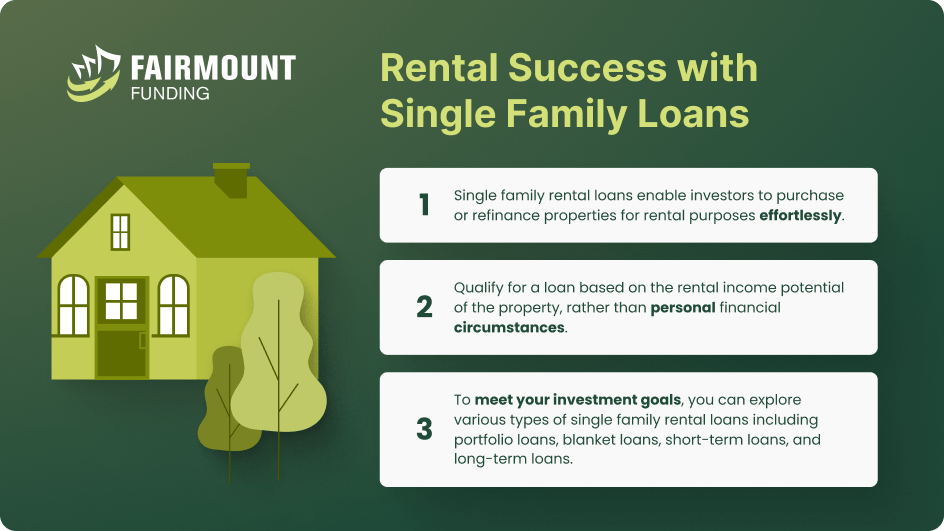
Single family rental loans is one of many types of loans for rental property that allows for investors to purchase or refinance a single-family home to rent it out. These financing options are ideal for property investors who want to build a rental property portfolio. That’s because investing in SFR properties can help them generate passive income and build long-term wealth.
SFR loans are different from traditional home loans, in that they are based on the potential rental income of the property, rather than the borrower’s income. This allows investors to qualify for a loan based on the cash flow of the property, rather than their financial circumstances. However, the terms and conditions of these loans vary widely depending on the lender.
With suitable funds, investors can purchase properties with little or no money and start earning rental income immediately. Let’s take a closer look at the different types of single family rental loans and how you can find the best financing options for your investment strategy.
What are single family rental loans?
Also known as investor or rental property loans, single family rental loans are designed to help real estate investors purchase or refinance properties intended for rental purposes. Here’s how single rental loans typically work:
- Property Acquisition. Investors identify a single-family property they wish to purchase as a rental investment. This property can be an existing home or a newly constructed one.
- Loan Application. The investor applies for loans for rental properties through a bank, credit union, or mortgage company. The loan application process typically involves providing financial information, documentation of the property, and details of the investment plan.
- Loan Approval. The lender evaluates the investor’s application and the potential rental income. If approved, the lender provides the investor with a loan offer.
- Down Payment. SFR loans require a down payment. Typically, it is equivalent to 20% to 30% of a property’s purchase price.
- Property Management. The investor may need to demonstrate a property management plan before closing the loan. It should outline how the property will be managed, including tenant screening, rent collection, maintenance, and repairs.
- Loan Closing. Once you and the lender agree on the loan terms, the following step is the loan closing. This includes signing the legal documents, and the funds are exchanged. You will then take ownership of the property and become responsible for the mortgage payments.
- Rental Income. You rent out the property to generate income and use it to cover mortgage payments. Other expenses to keep in mind are property taxes, insurance, and maintenance costs.
- Loan Repayment. The investor makes monthly mortgage payments to the lender based on the agreed-upon terms. These payments typically include both the principal amount borrowed and the interest accrued. That’s why the investor must generate sufficient rental income to cover the expenses and repay the loan over time.
The Popularity of SFR Properties
Single family rental (SFR) properties have become increasingly popular in recent years due to various factors.
- High demand. The COVID-19 pandemic triggered the “Great American Move” as households are relocating to less dense and more affordable places. Some of the reasons include the desire for more space, privacy, and outdoor areas.
- Demographic shifts. Millennials are also driving demand for rental properties. That’s because single family rentals are becoming the default starter home for the largest age cohort in American history.
- Reliable returns. Due to the high demand, the national median rent increased by a staggering 17.6% throughout 2021. As such, SFR properties have produced reliable returns over time.
Because of the growing popularity of SFR properties, it is not surprising that it has been the best-performing property class since 2019. Relatively, you now have concrete reasons to apply for a hard money loan for rental property and build your real estate portfolio.
SFR Loans vs. Primary Home Loans
You can submit a housing loan application to the bank, credit union, or mortgage broker for your primary residence. Nonetheless, single family rental loans differ from primary home loans in several key aspects.
Intended Use
Loans for rentals are ideal for real estate investors who want to purchase or refinance properties to rent them out. On the other hand, primary home loans are meant to buy or refinance a property that will be the borrower’s primary residence.
Down Payment
Rental property loans often require a higher down payment, equal to at least 20% of the property’s purchase price, than primary home loans. Meanwhile, the down payment for primary home loans can range between 3% and 20% depending on the loan program and borrower qualifications.
Interest Rates
Interest rates for single family rental loans are slightly higher than those for primary home loans. One reason is that investment properties are generally considered to have a higher risk than owner-occupied properties.
Qualification Criteria
Lenders evaluate rental property loan applications based primarily on the property’s income potential and the borrower’s creditworthiness. Their income may be considered, although it is usually not the primary factor.
On the other hand, the borrower’s income and creditworthiness are integral in qualifying for primary home loans. Lenders evaluate the borrower’s ability to make mortgage payments based on their income, employment history, credit score, and debt-to-income ratio.
Tax Implications
Rental property investors can take advantage of tax benefits like reduced mortgage interest, property taxes, maintenance expenses, and depreciation. However, they may also be subject to additional tax regulations that have to do with rental income and property ownership. Meanwhile, homeowners can take advantage of tax deductions on mortgage interest and property taxes, although this is subject to certain limits and qualifications.
Types of Single Family Rental Loans
One of the advantages of investing in single-family rental properties is the array of available real estate financing options. Here are some of the types of SFR loans that are available to real estate investors:
- Portfolio Loans. This type of financing solution allows investors to fund multiple rental properties with just one lender. This can help make it easier to manage multiple properties.
- Blanket Loans. It allows investors to finance multiple rental properties under one loan. Blanket loans can be a good option for investors who want to purchase multiple properties at once.
- Short-term Loans. This type of loan is ideal if you want to buy a property, renovate it, and then sell it immediately for a profit. Short-term loans can have higher interest rates and shorter repayment terms than other types of rental loans.
- Long-term Loans. It is meant for investors who want to hold onto a rental property for an extended period and generate income. As the name suggests, long-term loans typically have lower interest rates and longer repayment terms than short-term loans.
There are various places where investors can apply for the best loan for buying rental property.
- Banks and Mortgage Lenders. Many traditional banks and mortgage lenders offer rental property loans. You can approach local or national banks to inquire about their loan programs for real estate investors.
- Credit Unions. Credit unions, which are member-owned financial institutions, may also provide rental property loans with competitive rates and personalized service. If you are a member of a credit union, reach out to them and inquire about their investment property loan options.
- Private Lenders. Some private lenders specialize in property investment financing and offer single family rental loans. They may provide more flexible loan terms, especially for real estate investors who may need to meet the traditional banks’ strict requirements.
When looking for SFR loan providers, it is vital to research different lenders and compare their loan terms to find the best fit for your investment strategy.
Single Family Rental Loans FAQs
Why should I invest in single family rentals?
Single family rental properties are growing in popularity because they tend to be affordable and have higher appreciation. They also offer substantial tax write-offs, a passive rental income, and long-term capital appreciation.
How can I qualify for single family rental loans?
To qualify for a single family rental loan, it can help to have a high credit score and a reserve account. You may also need to prepare a business plan that shows the rental property’s income potential and your ability to manage it.
How can I use my single family rental loan?
The primary purpose of an SFR loan is to buy a property to rent it out. Depending on the type of loan you are applying for, you can use the funds to finance multiple rental properties with just one lender or under one loan.
Start Generating Rental Income with Single Family Rental Loans
Single family rental loans are financial tools designed to help real estate investors buy or refinance residential properties for rental purposes. These loans cater specifically to those seeking to generate rental income and build their investment portfolio.
Investors looking to venture into the rental property market can apply for single family rental loans from various sources, including banks, credit unions, online lending platforms, and specialized lenders. However, these loans typically require a higher down payment and may have slightly higher interest rates.
Nonetheless, obtaining a single family rental loan gives real estate investors the means to acquire and manage rental properties. This allows them to tap into a potential source of steady income. If you’re ready to seize the benefits of SFR loans, give us a call and let’s turn your rental property into a flourishing and profitable investment.
KEY TAKEAWAYS
- Single family rental loans help real estate investors purchase or refinance properties intended for rental purposes.
- SFR properties are growing in popularity because people are relocating to less dense and more affordable place.
- It is also becoming the default starter home among millennials.


